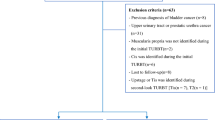Abstract
Purpose
Although the role of second transurethral resection of bladder tumor (TURB) is well established in high-risk non-muscle-invasive bladder cancer, to the best of our knowledge, there is no study regarding the role of a second transurethral resection (TUR) after a complete first TURB in multimodal therapy (MMT). The aim of this study was to evaluate the role of a second TUR on disease-specific survival (DSS) and overall survival (OS) rates in muscle-invasive bladder cancer (MIBC) patients who were treated with MMT.
Methods
We assessed the data of 90 patients (stage T2-4, N0-1, M0 urothelial cancer) who were treated with MMT at our clinic between January 2000 and June 2014. Patients with incomplete initial TURB were excluded. A total of 43 patients had a second TUR before starting radiochemotherapy of MMT (group 1), and 47 patients (group 2) were treated with MMT without having a second TUR. The impact of second TUR on DSS and OS rates was the primary outcome measure of the study.
Results
Mean (SD, range) age and mean follow-up of the patients were 65.1 (7.1, 52–81) years and 60.3 (38.3, 6–159) months, respectively. The two groups were similar with regard to sex, age, presence of hydronephrosis, lymph node involvement and stage. The 5-year DSS rate was better in group 1 compared to group 2 (68 vs. 41 %) (p = 0.046). The 5-year OS rates of the patients were 63.7 and 40.1 % in groups 1 and 2, respectively (p = 0.054). Multivariate analysis revealed that second TUR, lymph node involvement, presence of hydronephrosis and tumor stage were independent prognostic factors for DSS.
Conclusions
Second TUR should be performed in patients with MIBC who are going to be treated with bladder-preserving MMT protocols.


Similar content being viewed by others
References
Hautmann RE, de Petriconi RC, Pfeiffer C et al (2012) Radical cystectomy for urothelial carcinoma of the bladder without neoadjuvant or adjuvant therapy: long-term results in 1100 patients. Eur Urol 61:1039–1047
Hautmann RE, de Petriconi RC, Volkmer BG (2010) Lessons learned from 1,000 neobladders: the 90-day complication rate. J Urol 184:990–994
Efstathiou JA, Spiegel DY, Shipley WU et al (2012) Long-term outcomes of selective bladder preservation by combined-modality therapy for invasive bladder cancer: the MGH experience. Eur Urol 61:705–711
Krause FS, Walter B, Ott OJ et al (2011) 15-year survival rates after transurethral resection and radiochemotherapy or radiation in bladder cancer treatment. Anticancer Res 31:985–990
Ploussard G, Daneshmand S, Efstathiou JA et al (2014) Critical analysis of bladder sparing with trimodal therapy in muscle-invasive bladder cancer: a systematic review. Eur Urol 66:120–137
Mak RH, Hunt D, Shipley WU et al (2014) Long-term outcomes in patients with muscle-invasive bladder cancer after selective bladder-preserving combined-modality therapy: a pooled analysis of Radiation Therapy Oncology Group protocols 8802, 8903, 9506, 9706, 9906, and 0233. J Clin Oncol 32:3801–3809
Divrik RT, Sahin AF, Yildirim U, Altok M, Zorlu F (2010) Impact of routine second transurethral resection on the long-term outcome of patients with newly diagnosed pT1 urothelial carcinoma with respect to recurrence, progression rate, and disease-specific survival: a prospective randomised clinical trial. Eur Urol 58:185–190
Babjuk M, Burger M, Zigeuner R et al (2013) EAU guidelines on non-muscle-invasive urothelial carcinoma of the bladder: update 2013. Eur Urol 64:639–653
Herr HW (2001) Transurethral resection of muscle-invasive bladder cancer: 10-year outcome. J Clin Oncol 19:89–93
Rödel C, Grabenbauer GG, Kühn R et al (2002) Combined-modality treatment and selective organ preservation in invasive bladder cancer: long-term results. J Clin Oncol 20:3061–3071
Caffo O, Veccia A, Fellin G et al (2013) Trimodality treatment in the conservative management of infiltrating bladder cancer: a critical review of the literature. Crit Rev Oncol Hematol 86:176–190
Authors’ contribution
S Baltaci and K Turkolmez developed the protocol/project; N Hamidi: collected or managed the data and wrote/edited the manuscript; O Gulpinar and Y Beduk analyzed the data; E Suer wrote/edited the manuscript and analyzed the data; MI Gokce collected or managed the data.
Author information
Authors and Affiliations
Corresponding author
Ethics declarations
Conflict of interest
None.
Rights and permissions
About this article
Cite this article
Suer, E., Hamidi, N., Gokce, M.I. et al. Significance of second transurethral resection on patient outcomes in muscle-invasive bladder cancer patients treated with bladder-preserving multimodal therapy. World J Urol 34, 847–851 (2016). https://doi.org/10.1007/s00345-015-1710-5
Received:
Accepted:
Published:
Issue Date:
DOI: https://doi.org/10.1007/s00345-015-1710-5




